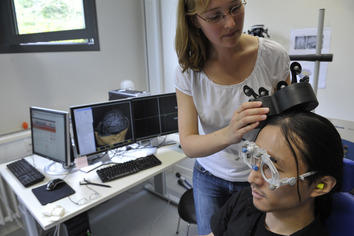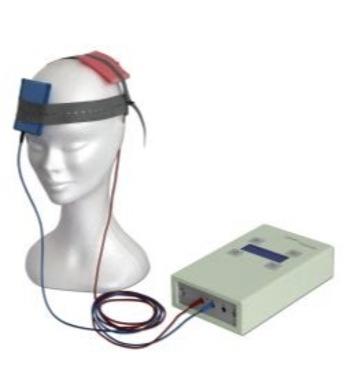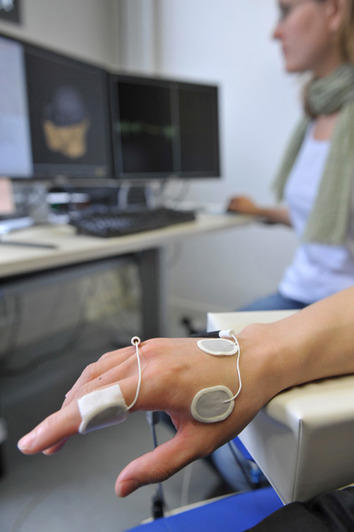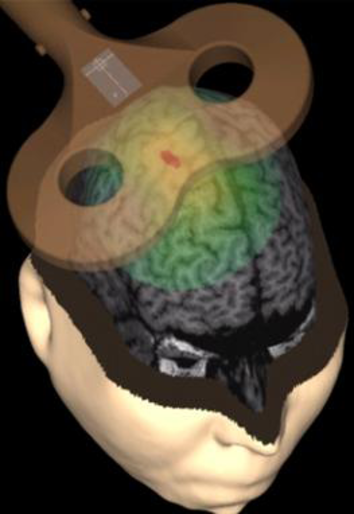Transcranial magnetic stimulation and transcranial direct current stimulation
Transcranial Magnetic Stimulation
Image Credit: Bernd Wannenmacher
Gleichstromstimulator
Erfassung der Handmuskelbewegungen durch EMG
Image Credit: Bernd Wannenmacher
Neuronavigation
In recent years, non-invasive methods of brain stimulation such as the transcranial magnetic stimulation (TMS) and the transcranial direct current stimulation (tDCS) have become increasingly important for neuroscientific research as well as for clinical use.
With these innovative methods, specific regions of the brain can be electrically stimulated through the skull (= transcranial). The primary target region for brain stimulations is the dorsolateral prefrontal cortex (DLPFC). It plays a crucial role in the processing of basic cognitive and emotional skills. A sufficiently long duration of stimulation leads to sustained changes in the excitability of cortical neurons, which last for several minutes or even several hours after the stimulation. The effects of a manipulation of neuronal activity can either be inhibitory or excitatory.
The use of non-invasive methods of brain stimulation enables researchers to investigate which neuronal structures are involved in cognitive processes and how emotions, memory, and language interact. By temporarily inhibiting specific brain areas (so called 'virtual lesions' are induced) causal links between cortical activity and cognitive task performance can be established.
Methods of stimulation can be implemented as therapeutical interventions for depression and several other psychiatric disorders. It has been shown that in many depressive patients, the left frontal lobe is less active and/or the right frontal lobe is more active than normal. This abnormal brain activity can be modulated through repeated stimulation of the frontal lobe, which can lead to a reduction in the depressive symptoms.
During transcranial direct current stimulation (tDCS), a continuous current is administered through two electrodes which are placed on the scalp. Depending on the polarity of the stimulation, a reduction or an increase in cortical excitability can be achieved.
Both methods of stimulation are painless and free of side effects, and can be implemented in healthy subjects as well as in patients with psychiatric or neurological disorders. Subjects are awake during the treatment, rendering anesthesia unnecessary.
Technique
In TMS, a coil is placed on the skull tangentially to the surface. When a pulse is triggered, this coil induces an electric field in the underlying cortex via a temporarily changeable magnetic field. Repetitive TMS (rTMS) is when series of pulses of a certain frequency are applied. Depending on the frequency used, specific brain regions can be excited or inhibited. The intensity of the stimulation is defined by the individual threshold of cortical excitability. This threshold is determined by another threshold: the motor threshold. It is the minimal stimulus strength which reliably elicits a motoric reaction in the relaxed muscle. To this end, single TMS pulses are administered to the motor cortex and muscle movements of the hand are measured with the help of an electromyogram (EMG).
Using stereotactic neuronavigation enables a precise positioning of the magnetic coil to stimulate the intended brain region. Thereby, the position of the coil relative to the individual brain anatomy is projected onto a computer screen. Movements of the coil during the stimulation can be tracked in real-time.
Laboratory
The MAGSTIMLAB includes two TMS devices (MagVenture MagPro X100 and Nexstim NBS System) which can be neuronavigated. An additional stimulator (magstim Rapid²) can be used simultaneously with functional magnetic resonance imaging (fMRI). For the application of transcranial direct current stimulation, two battery-operated stimulators are used (NeuroConn and Schneider Electronic).



